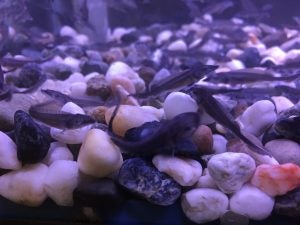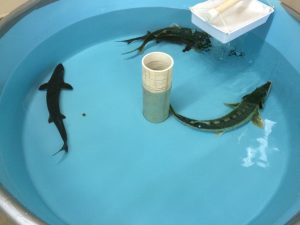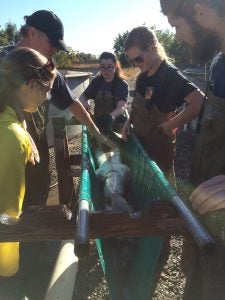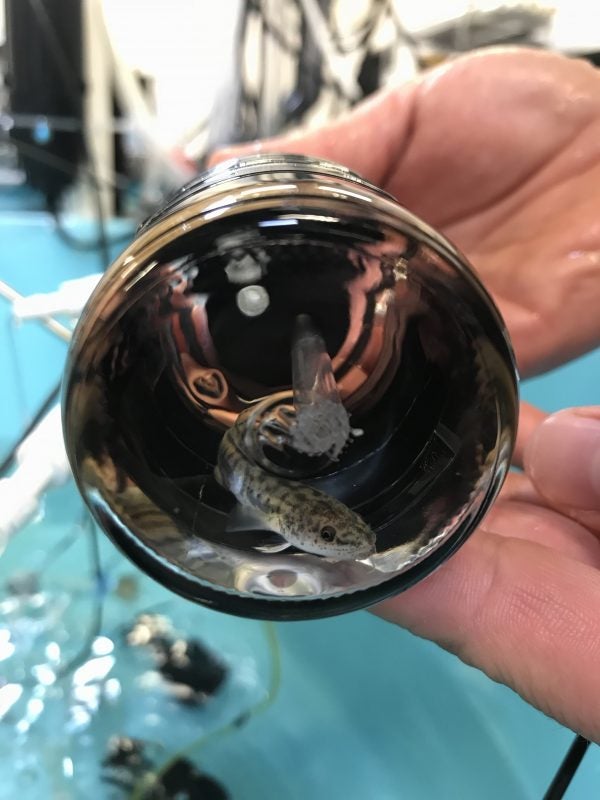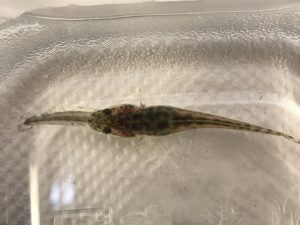In 2004, 68% of total production of fish, crustaceans and mollusks (termed seafood, coming from fresh, brackish and salt water) came from capture fisheries and the remaining 32% from aquaculture. Today, aquaculture supplies over half of the world’s total seafood production, and as the fastest growing animal food production sector is poised to supply two-thirds of global seafood production by the year 2030. Our decreased reliance on capture fisheries is due in part to over-harvesting of stocks but has also been impacted by climate variability that results in changes in fish supply. In turn, our reliance on aquaculture has increased and is projected to continue to grow as the demand for seafood increases and climate change continues to impact aquatic ecosystems.
Much of the growth in aquaculture has and will continue to come from intensification of production systems, which may increase the strains placed on animals in these systems. Intensification can result in increased stress associated with increased handling, increased stocking densities and deterioration of water quality, diverting energy away from growth and development and potentially making them more sensitive to additional stressors or disease. Overlay the increasing challenges from climate change, particularly warming of aquatic environments and persistent drought, and scenarios emerge where the development of new aquaculture practices to increase efficiency are directly intertwined and related to the capacity of the animals to cope with climate change. To mitigate future impacts of climate change on aquaculture, there is a need to increase the efficiency of aquaculture production systems while preserving the stress tolerance or resilience of aquaculture species to changing environmental factors.
Recent Projects
Oyster Aquaculture
Shifts in temperature and other climate change related stressors will have direct consequences on the world’s future food production and security. As the global human population continues to grow, so does the demand for sustainable protein sources. Capture fisheries are stagnating and aquaculture is the fastest growing food production sector globally, and now produces more seafood than wild capture fisheries with production expected to at least double by 2050. The state of California has recently put new attention towards developing a state-wide aquaculture action plan that emphasizes minimizing environmental impact. Because of this, the optimization of low-trophic, filter-feeding species such as shellfish will be particularly important because of their ecological efficiency. Of the more than 300 commercial shellfish farms along the U.S. West Coast, California hosts only 19 (in part due to relatively high regulatory costs) but is poised to expand. Oysters are the dominant mollusk grown and specifically the Pacific oyster, Crassostrea gigas, accounts for over 50% of total oyster sales in California.
Using the Pacific oyster, PhD student Hollis Jones has partnered with local oyster farm, Hog Island Oyster Co., to to 1) characterize how different stages of the aquaculture process alter standing genetic diversity; 2) explore the benefits of culturing a diverse portfolio of genetic strains by experimentally testing whether a new strain of the Pacific oyster is more resilient to an atmospheric heatwave; and 3) test whether priming hatchery produced oysters with air allows them to more efficiently transition from a fully subtidal environment in the hatchery to the intertidal leases. All of these projects aim to better understand the effects of current hatchery practices on the genetic diversity and physiology of Pacific oysters and to test the effectiveness of management strategies that could be implemented to enhance oyster resilience.
Sturgeon Aquaculture
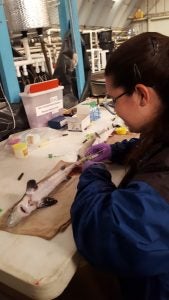 Carrying on from decades of foundational research on sturgeon physiology and hatchery technology of cultured sturgeon by Dr. Serge Doroshov in the Department of Animal Science at UC Davis, we are developing research in our group that will focus on understanding the interactive effects of hatchery-associated stressors and climate change stressors on the physiological performance and disease resistance of white sturgeon across developmental stages. One mechanism of increasing productivity in aquaculture is through the production of triploid fish. Triploids contain an extra set of chromosomes, which typically results in sterility. Sterile fish have the potential to reallocate energy from reproductive growth to somatic growth, resulting in increased growth and production rates. White sturgeon are unique compared to many other species of fishes, in that triploids are actually fertile and are, therefore, still potentially useful in caviar production. However, there is still much to be learned about triploid fish physiology, especially with the increasing amount of evidence that suggests triploids underperform in suboptimal conditions (i.e. low oxygen and high temperature environments) compared to diploids. Our research aims at understanding if and how diploid and triploid white sturgeon differ in their stress, metabolic, and immunological physiology under different environmental conditions.
Carrying on from decades of foundational research on sturgeon physiology and hatchery technology of cultured sturgeon by Dr. Serge Doroshov in the Department of Animal Science at UC Davis, we are developing research in our group that will focus on understanding the interactive effects of hatchery-associated stressors and climate change stressors on the physiological performance and disease resistance of white sturgeon across developmental stages. One mechanism of increasing productivity in aquaculture is through the production of triploid fish. Triploids contain an extra set of chromosomes, which typically results in sterility. Sterile fish have the potential to reallocate energy from reproductive growth to somatic growth, resulting in increased growth and production rates. White sturgeon are unique compared to many other species of fishes, in that triploids are actually fertile and are, therefore, still potentially useful in caviar production. However, there is still much to be learned about triploid fish physiology, especially with the increasing amount of evidence that suggests triploids underperform in suboptimal conditions (i.e. low oxygen and high temperature environments) compared to diploids. Our research aims at understanding if and how diploid and triploid white sturgeon differ in their stress, metabolic, and immunological physiology under different environmental conditions.
Burbot Aquaculture
In addition to helping meet the increasing demand for seafood, aquaculture is an important tool for conservation efforts that are not directly related to food production. In the Kootenai River population of burbot, Lota lota, in Northern Idaho, conservation hatcheries have played a pivotal role in the re-establishment of the local population following extirpation due to nearby damming. In conservation hatcheries and in aquaculture alike, cannibalism (the act of eating flesh of the same species) is a primary issue. While cannibalism is common behavior in fishes, it is known to increase in aquaculture settings and has been documented as high as 45% in burbot. Conservation hatcheries typically follow the common aquaculture practice of reducing cannibalism as much as possible in order to maximize yield. Cannibal burbot, however, are significantly larger than non-cannibals, suggesting a performance advantage. If cannibals do indeed exhibit greater performance than their non-cannibal siblings, there may be interest in allowing cannibalism in the conservation hatchery. Funded by the Kootenai Tribe of Idaho (grant number 74960), we are currently examining the potential metabolic performance benefits of a cannibal feeding strategy in burbot using molecular and organismal techniques (including RNA-Seq, cellular metabolic enzyme activities, and whole-animal respirometry). Our research has found that cannibal and non-cannibal burbot exhibit distinct metabolic strategies and supports the idea that the different feeding strategies may indeed demonstrate larger physiological performance differences. This project provides an example for the importance of using hatcheries to achieve conservation goals.
Publications
Frazier, A.J., Jensen, N.R., Young, S.P., Todgham, A.E. 2020. Does a cannibal feeding strategy impart differential metabolic performance in young burbot (Lota lota maculosa)? Conserv Physiol 8(1): coaa034; doi:10.1093/conphys/coaa034.
Van Eenennaam, J.P., Fiske, A.J., Leal, M.J., Cooley-Rieders, C., Todgham, A.E., Conte, F.S., Schreier, A.D. 2019. Mechanical shock during egg de-adhesion and post-ovulatory ageing contribute to spontaneous autopolyploidy in white sturgeon culture (Acipenser transmontanus). Aquaculture
Leal, M.J., Van Eenennaam, J.P., Schreier, A.D., Todgham, A.E. 2019. Diploid and triploid white sturgeon differ in magnitude of physiological responses to exhaustive exercise at ambient and elevated temperature. Canadian Journal of Fisheries and Aquatic Science
Fiske, A.J*, Van Enenennaam, J.P., Todgham, A.E., Young, S.P., Holem-Bell, C.E., Goodbla, A.M., and Schreier, A.D. 2019. A comparison of methods for determining ploidy in white sturgeon (Acipenser transmontanus). Aquaculture.
Leal, M.J.*, Van Eenennaam, J.P., Schreier, A.D., and Todgham, A.E. 2019. Triploidy in white sturgeon (Acipenser transmontanus): Effects of acute stress and warm acclimation on physiological performance. Comp. Biochem. Physiol. A. 229:10-17.
Leal, M.J.*, Clark, B.E.#, Van Eenennaam, J., Schreier, A.D., and Todgham, A.E. 2018. The effects of warm temperature acclimation on constitutive stress, immunity, and metabolism in white sturgeon (Acipenser transmontanus) of different ploidies. J. Comp. Biochem. Physiol. A. 224:23-34.
